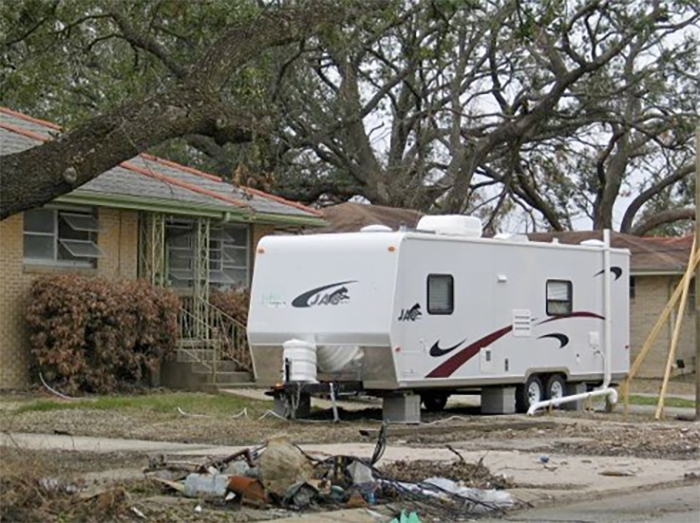
Taking a Breather: Testing for Formaldehyde in Wood
Around the same time that Hurricane Katrina devastated New Orleans, Louisiana, in August 2005, Dustin Poppendieck, Ph.D., had just started teaching freshman environmental engineering majors at Humboldt State University in California. It couldn’t have been a better introduction to the topic. “It was a timely way to introduce crucial topics such as levees, water treatment, disaster planning, and testing for mold and air quality,” he says.
Poppendieck traveled to New Orleans with a team of researchers following the hurricane. They visited 10 houses and a school to determine what species of mold were present, to test the airborne mold-spore concentrations, and to measure the change in moisture in the wallboard and studs.
In the aftermath of the hurricane, among other impacts, came a housing shortage. The U.S. Federal Emergency Management Agency tried to address this in part by expediting the delivery of clean, new trailers. The trailers, however, soon posed their own problems for occupants, who began to have health issues such as nosebleeds, headaches, and breathing problems.
Testing from 2006 to 2008 revealed the problem to be wood products in the trailers that emitted formaldehyde at a high rate, with concentrations five to 40 times those found in an average home.
FOR YOU: Resilience = Durability + Sustainability
The source of the problem was determined to be urea formaldehyde used to make wood products such as plywood, chipboard, furniture, and floors. And due to the large amount of wood used in the trailers, the problem was even more pronounced.
Formaldehyde Legislation
In March 1992, the California Air Resources Board (CARB) identified formaldehyde as a toxic air contaminant. Additionally, the International Agency for Research on Cancer classified formaldehyde as a human carcinogen in 2004.
In April 2007, CARB approved the Composite Wood Products Airborne Toxic Control Measure, a regulation intended to reduce formaldehyde emissions from goods made, supplied, sold, or used in California. The law focuses on hardwood plywood, particleboard, and medium density fiberboard, all of which must meet emissions standards.
Spurred on by the trailer air quality problems, the U.S. Environmental Protection Agency (EPA) worked with CARB to help ensure the EPA rule would be consistent with the California requirements. The federal Formaldehyde Standards for Composite Wood Products Act was passed in 2010. The final rule was published by EPA in 2016 and the regulation came into full effect in March 2019.
(Also notably, in 2011, the National Toxicology Program, an interagency program of the U.S. Department of Health and Human Services, named the chemical a known human carcinogen in its 12th Report on Carcinogens.)
Both the CARB measure and the EPA regulation require the use of ASTM International standards to test formaldehyde emissions from wood products.

In the aftermath of Hurricane Katrina, formaldehyde emissions in temporary housing trailers like this one led to health issues such as nosebleeds, headaches, and breathing problems. Credit: Dustin Poppendiek.
Standards to Test Formaldehyde Levels
ASTM International was already home to standards that evaluate structural composite lumber products (D5456) and establish and monitor structural capacities of prefabricated wood I-joists (D5055). To build on that, ASTM formaldehyde testing standards now provide crucial methods to quantify the formaldehyde emissions from wood products.
The standards, maintained by the committee on wood (D07), include these cited by both CARB and EPA, among others:
- Test method for determining formaldehyde concentrations in air from wood products using small-scale chamber (D6007), and
- Test method for determining formaldehyde concentrations in air and emission rates from wood products using large chamber (E1333).
“These are methods that essentially every composite wood product used indoors has to meet,” says Poppendieck, now an environmental engineer with the U.S. National Institute of Standards and Technology,
Reference Material Underway
Poppendieck continues to serve as an expert in quantifying emissions into indoor air from household products and building materials. “Little did I know I would still be dealing with some of the issues revealed by Hurricane Katrina nearly 15 years later as a scientist at NIST,” he says.
Today, he and his colleagues are working toward a reference material that can be used and reused in formaldehyde emission testing.
“My goal, along with my NIST colleague Mengyan Gong, is to create a reusable source that releases formaldehyde into an emission chamber in a controlled way and can be used with the testing techniques required by CARB and EPA statutes,” says Poppendieck. “This will allow testing labs to certify results faster without requiring time-consuming studies comparing the results achieved by multiple laboratories.”
Poppendieck and his colleagues must take variables into account that affect formaldehyde measurements, from temperature and humidity to the measurement approach itself.
The work continues. Poppendieck describes the reference material status: “Currently, our prototype reference material consists of a bottle made of stainless steel and a material commonly used as a nonstick coating. The bottle is filled with a solution of formaldehyde in water. Release of formaldehyde from the bottle is limited by a replaceable thin membrane in the cap.”
The end result will be useful to labs and ultimately, consumers. “We hope that after further testing, we can produce a reference material that will give consumers confidence that the wood products, cabinets, and flooring they buy at their local home improvement store will not emit significant amounts of formaldehyde,” says Poppendieck.
 SN Home
SN Home Archive
Archive Advertisers
Advertisers Masthead
Masthead RateCard
RateCard Subscribe
Subscribe Email Editor
Email Editor